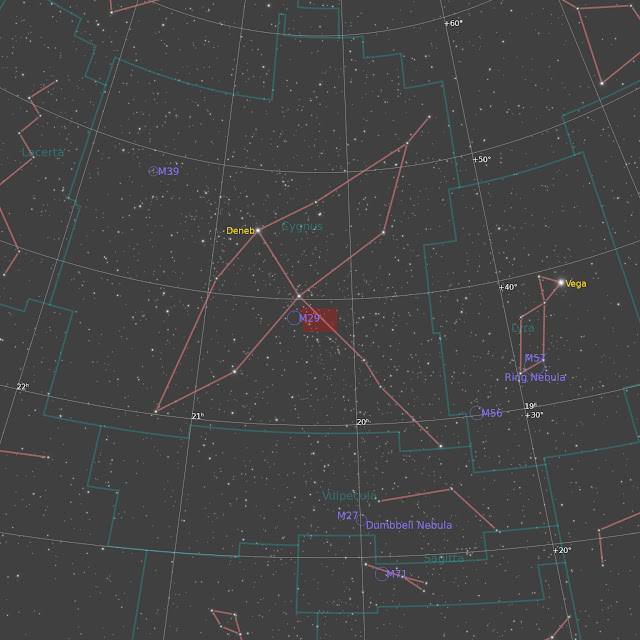This target was way too close to the nearly Full Moon ...
The night of February 20th was just a few days before The Full Moon (2/24). Even worse, this bright Moon was in the Constellation Gemini. This meant the Moon was very close to that night's target, The Rosette Nebula. Well, I wanted to see just how well the Optolong L-eXtreme Dual Narrowband filter would perform under these unfair circumstances. Spoiler alert, it wasn't great, but it wasn't a total loss.
I got home from work and setup my rig. As we are approaching spring, it is staying light noticeably later. This takes a little pressure off when getting setup (nothing worse than setting up under a clear dark sky). It still gets dark early enough to get a decent amount of imaging before it is too late. This will change as Spring turns towards Summer. I started collecting subs (short for sub-exposures) at 7:11 PM and stopped at 10:00 PM due to clouds. Exposure time was 180 sec each at Gin 100 / Offset 50 / -10 deg C. Ended up using 44 subs (2.2 hours total exposure) to produce the image. I oriented the object to show the Skull. Please note, there is a separate deep sky object called the Skull Nebula. My daughter is a Radiology Technician and has always had a fascination with bones, skeletons, and skulls. So, I guess this is in her honor.
 |
| NGC 2237 - The Rosette Nebula. Do you see the skull? |
So, what about that Moon thing? Well, it was an issue. The image below is a single exposure (sub) with Boosted Auto Stretch applied. Thankfully we have many capable tools to deal with Gradients. No doubt this gradient impacted the processing of the image, but I'm pleased with how it ended up after processing.
 |
| Single exposure showing Gradient from the Moon. |
Processing:
I did all pre and post processing in PixInsight. Pre-processing: Blink & WBPP. Linear Post-processing: Dynamic Background Extraction (DBE - see next paragraph), BlurXTerminator (correct only), Spectrophotometric Color Calibration, BlurXTerminator, NoiseXTerminator, and Histogram Transformation. Non-Linear Post-processing: StarXTerminator. Starless: Narrowband Normalization (simulated SHO), Curves (Multiple iterations to increase brightness, contrast, and color saturation), SCNR, Local Histogram Equalization, Unsharp Mask, and Multiscale Median Transform. Stars: Curves (to increase color saturation) and SCNR. PixelMath was used to screen the stars back in.I tried two different methods of Gradient removal. Specifically, DBE, GraXpert, and the new Gradient correction process. To my eye DBE gave me the best result. GraXpert removed too much nebula and the new Gradient Correction Tool did not seem to work well with this image. Note: This is a new tool so it could also be that I did not apply it in the optimal manner.
What is it?
The Rosette Nebula contains multiple deep sky objects, including bright nebulosity and a star cluster (NGC 2244). NGC 2237 usually denotes the whole nebula. Other objects contained in the area include NGC 2238, NGC 2239, & NGC 2246. The nebula is in the constellation Monoceros. The Nebula has a circular pattern that resembles a flower. However, it can be oriented (as shown in my images) in a way that resembles a Skull. As indicated above there is an entirely separate deep sky object known as the Skull Nebula (NGC 246).
This object is an emission nebula. Stellar winds from the hot, large, and young stars in the star cluster have carved out the central area. These stellar winds also exert pressure on the remaining gas and dust. This leads to star formation, which is actively occurring in the nebula.
How Big is it?
This object has an apparent size of 80 by 60 arcminutes (1 degree is 60 arcminutes) on the night sky. It is 128 light-years (ly) in diameter.
How Far is it?
It is located about 5,500 light-years (ly) from Earth in the Constellation Monoceros.
How to find it?
This object is easier to photograph than visually observe. To visually observe you will need requires dark skies and good seeing conditions, specifically transparency. A wide field telescope with a large field of view is required to see the entire object, as it is 5 times the size of the Full Moon in the sky. Large telescopes (over 8 inches) can reveal the dark nebulosity contained with the object.
Even though the constellation Monoceros is relatively dim, this object is relatively easy to locate. It is roughly halfway between the bright stars Betelgeuse (in Orion) and Procyon (in Canis Minor) as indicated in the finder chart below.

























